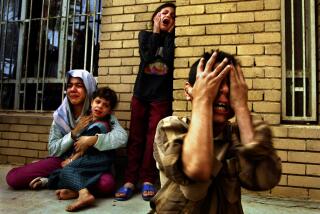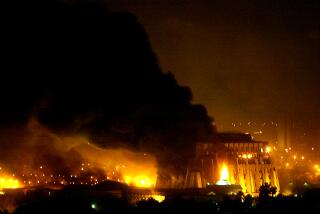Antiquities Scattered Throughout Iraq
- Share via
BABYLON, Iraq — History runs deep by the rivers of Babylon, but the heritage of the world’s oldest civilization is being scattered on the winds.
Plundered and sacked by invaders over the centuries, little remains of the world’s first cities, built in the fertile plains of southern Iraq by the Sumerians more than 5,000 years ago.
At present-day Babylon, modern bricks of sand were used to recreate the walls of the court of King Nebuchadnezzar, which flourished six centuries before Christ.
Tourists, virtually barred by Iraq since it went to war with Iran in 1980, are few. It is an empty, echoing place, its silence broken only by the hoot of a bird and the call to prayer drifting on the wind from a mosque.
Palm groves along the banks of the mighty Euphrates River stand as rustling sentinels at the site of the Hanging Gardens, once one of the Seven Wonders of the World.
Like much of Iraq’s rich heritage, the palace’s Ishtar Gate--45 feet high and patterned with fabulous animals--was excavated in 1902 and carted off to a Berlin museum.
Chapter after chapter of guidebooks to Iraq’s historical sites, from Nineveh in the north to Ur in the south, begin with the words “The ruins of. . . .”
At Babil (modern Babylon), about 55 miles south of Baghdad, piles of battered and time-worn stones protrude from the ground at intervals to mark where ancient buildings stood.
Iraq’s archeological treasures came under renewed threat after its Gulf War defeat.
The great Shiite Muslim shrines of Karbala and Najaf, badly damaged in the uprising that followed the Iraqi army’s expulsion from Kuwait, were reopened in September after extensive restoration.
Baghdad--the heart of Mesopotamia, the land between the rivers Tigris and Euphrates--probably suffered less from U.S. and British cruise missiles and bombs in 1991 than from its sacking by the Mongols in 1258, when the city’s libraries were wrecked and its vital irrigation system ruined.
Bridges and communication centers were destroyed in this year’s brief war but Baghdad’s ancient landmarks escaped virtually unscathed.
The central Iraqi Museum was damaged by debris from a bomb blast. Its priceless collection of antiquities had been moved to sites around the country for safe-keeping, but parts of it fell victim to the Shiite uprising in the south and a parallel revolt by autonomy-seeking Kurds in the north.
Eight of Iraq’s 14 archeological museums were looted after the Gulf War, said Muayed Said Damerji, the country’s director of antiquities.
“Collections of gold, silver and cooper coins are nowhere to be found, 5,000-year-old cuneiform tablets were broken into pieces and thrown into the streets, exquisite jewelry was removed from inside iron boxes and trunks of priceless relics scattered around,” he said.
“How can you compensate for the loss of a 5,000-year-old statue?” he asked.
Muayed said allied bombing and ground forces had damaged the ruins of the famed ziggurat (terraced pyramid) of Ur and razed an ancient church in the northern city of Mosul.
“But the heaviest damage was inflicted by the rioters who rampaged through several Iraqi cities following the cease-fire declaration,” he said.
Archeologists said it had not yet been possible to establish the number and type of lost artifacts.
The Ministry of Culture and Information has offered substantial rewards for anyone reporting or returning a missing relic.
“Every day we receive reports of antiquities thrown here and there across the country,” one official said.
More to Read
Sign up for Essential California
The most important California stories and recommendations in your inbox every morning.
You may occasionally receive promotional content from the Los Angeles Times.










